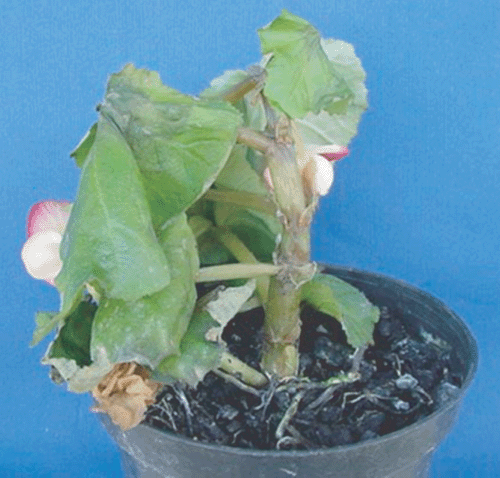Ralstonia solanacearum race 1/biovar III causing wilt of begonia in the State of São Paulo, Brazil
I. M. G. Almeida A D , J. Rodrigues Neto A , V. A. MalavoltaA Instituto Biológico, Caixa Postal 70, CEP 13001-970, Campinas, SP, Brazil.
B Instituto Agronômico, Caixa Postal 28, CEP 13001-970, Campinas, SP, Brazil.
C UNIPINHAL, Caixa Postal 5, CEP 13990-000, Espírito Santo do Pinhal, SP, Brazil.
D Corresponding author. Email: gatti@biologico.sp.gov.br
Australasian Plant Disease Notes 2(1) 99-99 https://doi.org/10.1071/DN07041
Submitted: 26 April 2007 Accepted: 20 June 2007 Published: 3 July 2007
Abstract
A natural occurrence of Ralstonia solanacearum causing wilt on begonia plants was observed for the first time in Brazil. Pathogenicity and biochemical tests placed the isolates into race1/biovar III.
Plants of begonia (Begonia elatior cv. Barkos) growing in pots under greenhouse conditions, located at the counties of Atibaia and Holambra, State of São Paulo, Brazil, and showing symptoms of wilt were observed during the year of 2003. Symptoms also included unilateral yellowing of leaves and irregular flowering, with subsequently wilt and death of the plant (Fig. 1). The vascular tissues of roots and stems of wilted plants showed a brown discolouration suggesting that Ralstonia solanacearum could be associated with the disease. Isolations on Kelman’s TZC medium (Kelman 1954) yielded pink and slimy colonies. Further tests confirmed the identification of the bacteria as R. solanacearum. Three isolates were used for inoculations and biovar determination (Hayward 1964; Hayward et al. 1990).

|
For the pathogenicity tests, healthy plants of begonia growing in pots under greenhouse conditions were inoculated. A droplet of the bacterial suspension (~107 cfu/mL) was placed in a leaf axil followed by puncture of the stem surface with a sterile needle to introduce the bacterial cells into the tissue. The plants were observed for 21 days after inoculation for symptom development. The inoculated plants reproduced the disease symptoms and the bacterium was recovered from these plants. The same procedure was used for inoculations on tomato and potato plants, and the begonia isolates were highly virulent to these plants.
Based upon reactions of the oxidation/utilisation of carbohydrates, the R. solanacearum isolates from begonia plants were found to belong to race 1/biovar III.
This is the first report of the occurrence of Ralstonia solanacearum race 1/biovar III in Begonia elatior. Janse et al. (2006) described the occurrence of R. solanacearum race 1/biovar I on leaves of B. elatior showing wilting and yellowing from a nursery that imported cuttings from Costa Rica in 2003, and these authors also found that some cuttings were latently infected with that bacterial species.
Cultures were deposited on the Phytobacteria Culture Collection of Instituto Biologico (IBSBF) under accession numbers 1839, 1882 and 1883.
Hayward AC
(1964) Characteristics of Pseudomonas solanacearum. Journal of Applied Bacteriology 27, 265–277.

Hayward AC,
El-Nashaar HM,
Nydegger U, De Lindo L
(1990) Variation in nitrate metabolism in biovars of Pseudomonas solanacearum. Journal of Applied Bacteriology 69, 269–280.

Kelman A
(1954) The relationship of pathogenicity in Pseudomonas solanacearum to colony appearance on a tetrazolium medium. Phytopathology 44, 693–695.



